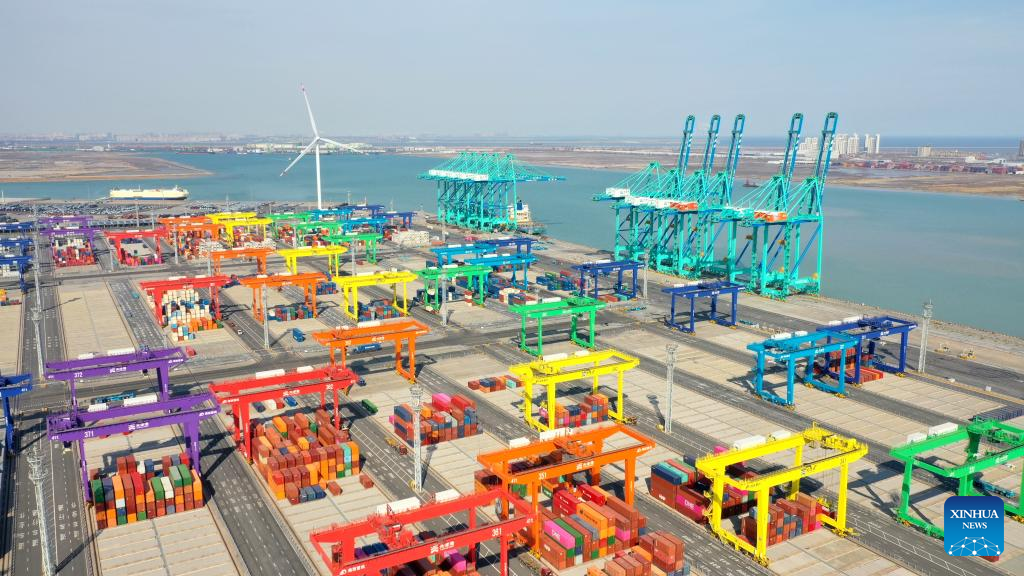
This aerial photo taken on Feb. 21, 2023 shows the full Internet of Things container terminal of Tianjin Port in north China's Tianjin.
As the "maritime gateway" to the Beijing-Tianjin-Hebei region, Tianjin Port has been ceaselessly advancing the construction of a smart port, boosting the coordinated development of the region with fresh impetus.
A full Internet of Things container terminal started operations in January this year in Tianjin Port, which connects six IoT elements, including people, vehicles, containers, ships, aircraft, and sites.
Equipped with more than 100 thousand types of sensors, the terminal is upgraded from a smart container terminal with zero carbon emissions. (Xinhua/Zhao Zishuo)
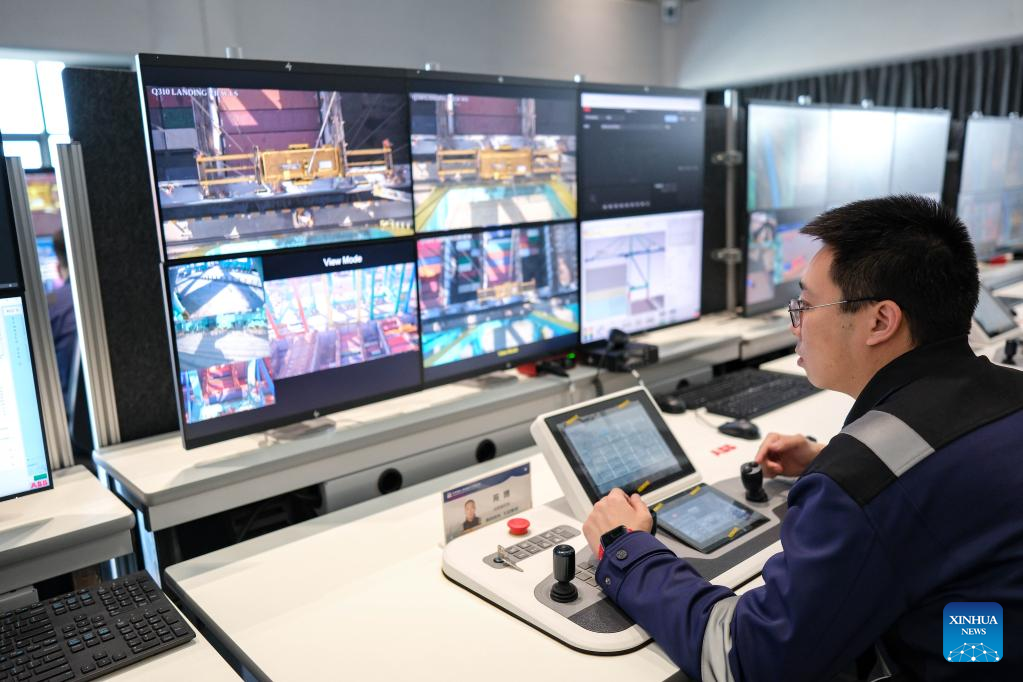
A staff member operates equipment at the technology center of the full Internet of Things container terminal of Tianjin Port in north China's Tianjin, Feb. 21, 2023.
As the "maritime gateway" to the Beijing-Tianjin-Hebei region, Tianjin Port has been ceaselessly advancing the construction of a smart port, boosting the coordinated development of the region with fresh impetus.
A full Internet of Things container terminal started operations in January this year in Tianjin Port, which connects six IoT elements, including people, vehicles, containers, ships, aircraft, and sites.
Equipped with more than 100 thousand types of sensors, the terminal is upgraded from a smart container terminal with zero carbon emissions. (Xinhua/Zhang Cheng)
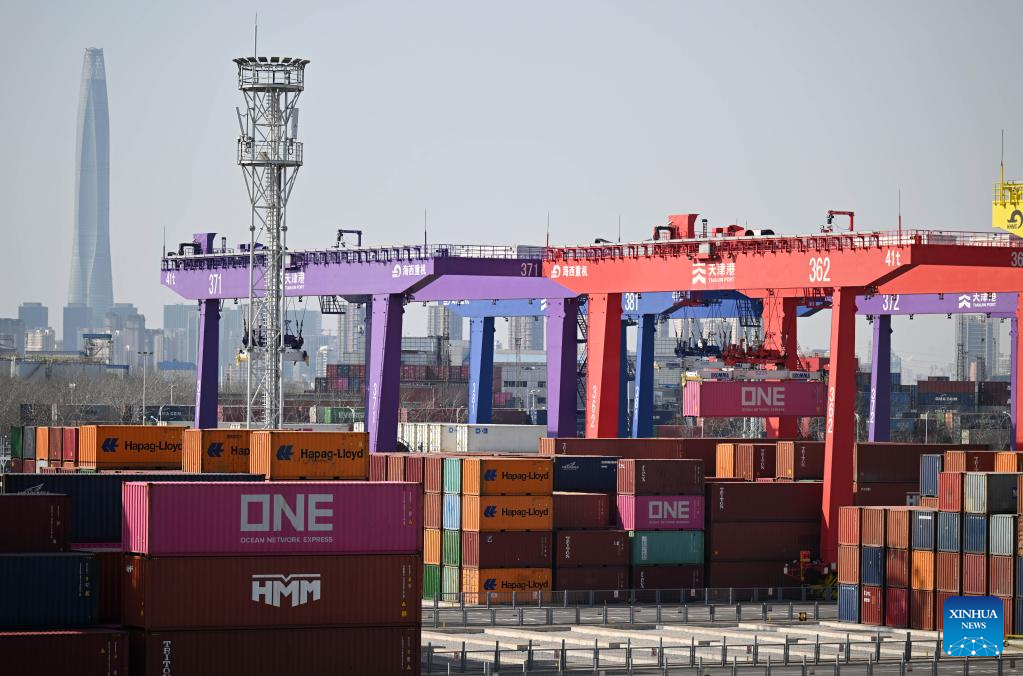
This photo taken on Feb. 21, 2023 shows the full Internet of Things container terminal of Tianjin Port in north China's Tianjin.
As the "maritime gateway" to the Beijing-Tianjin-Hebei region, Tianjin Port has been ceaselessly advancing the construction of a smart port, boosting the coordinated development of the region with fresh impetus.
A full Internet of Things container terminal started operations in January this year in Tianjin Port, which connects six IoT elements, including people, vehicles, containers, ships, aircraft, and sites.
Equipped with more than 100 thousand types of sensors, the terminal is upgraded from a smart container terminal with zero carbon emissions. (Xinhua/Li Ran)
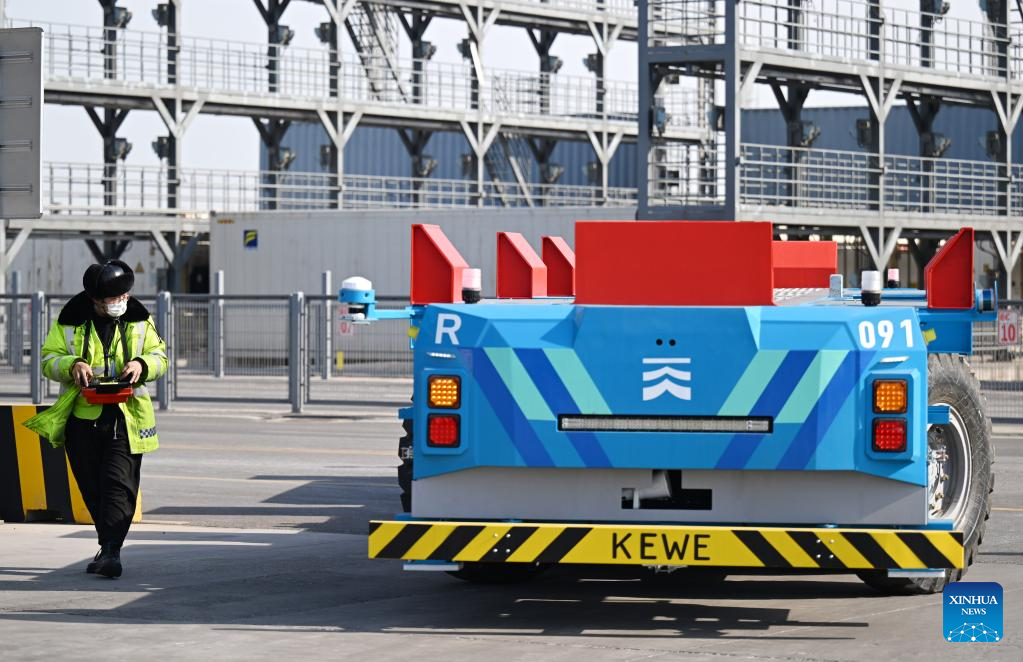
A staff member operates a smart delivery robot at the full Internet of Things container terminal of Tianjin Port in north China's Tianjin, Feb. 21, 2023.
As the "maritime gateway" to the Beijing-Tianjin-Hebei region, Tianjin Port has been ceaselessly advancing the construction of a smart port, boosting the coordinated development of the region with fresh impetus.
A full Internet of Things container terminal started operations in January this year in Tianjin Port, which connects six IoT elements, including people, vehicles, containers, ships, aircraft, and sites.
Equipped with more than 100 thousand types of sensors, the terminal is upgraded from a smart container terminal with zero carbon emissions. (Xinhua/Li Ran)
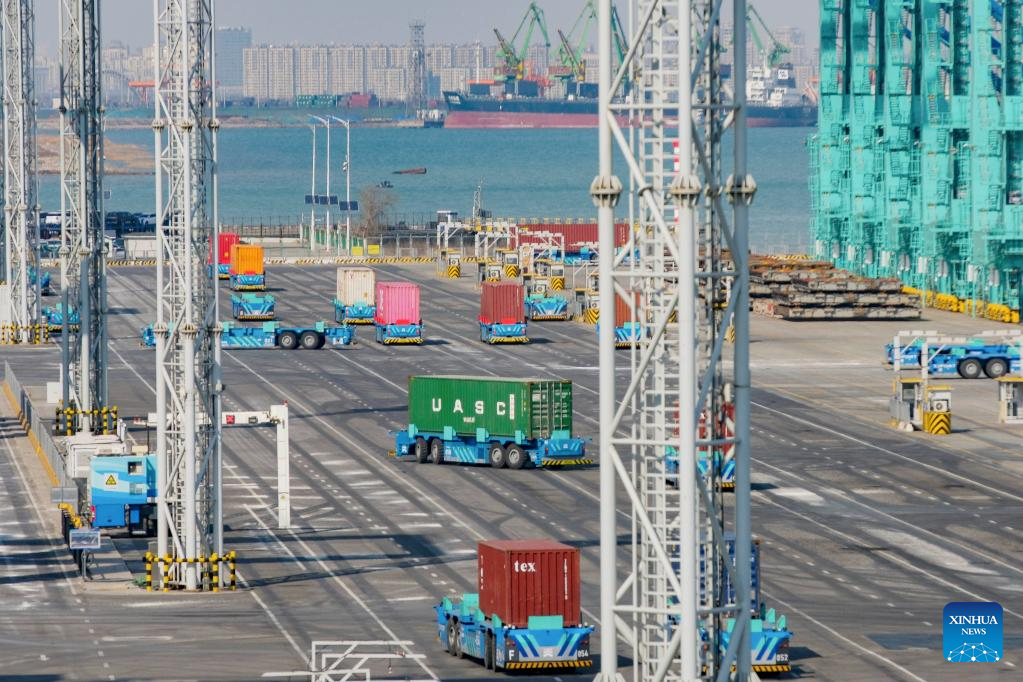
Smart delivery robots work at the full Internet of Things container terminal of Tianjin Port in north China's Tianjin, Feb. 21, 2023.
As the "maritime gateway" to the Beijing-Tianjin-Hebei region, Tianjin Port has been ceaselessly advancing the construction of a smart port, boosting the coordinated development of the region with fresh impetus.
A full Internet of Things container terminal started operations in January this year in Tianjin Port, which connects six IoT elements, including people, vehicles, containers, ships, aircraft, and sites.
Equipped with more than 100 thousand types of sensors, the terminal is upgraded from a smart container terminal with zero carbon emissions. (Xinhua/Zhang Cheng)
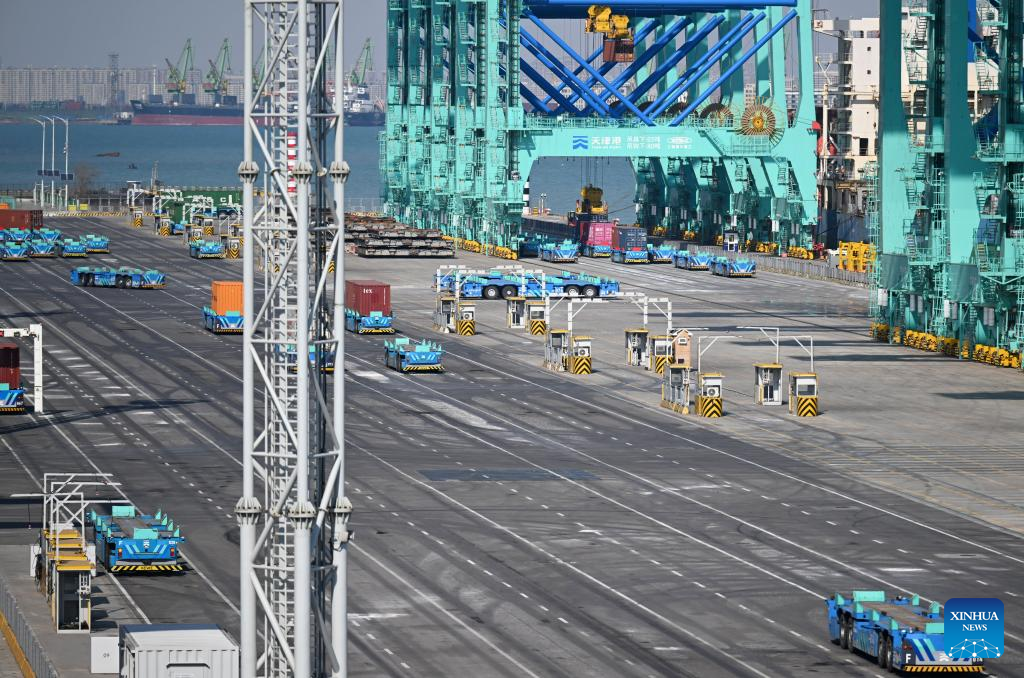
Smart delivery robots work at the full Internet of Things container terminal of Tianjin Port in north China's Tianjin, Feb. 21, 2023.
As the "maritime gateway" to the Beijing-Tianjin-Hebei region, Tianjin Port has been ceaselessly advancing the construction of a smart port, boosting the coordinated development of the region with fresh impetus.
A full Internet of Things container terminal started operations in January this year in Tianjin Port, which connects six IoT elements, including people, vehicles, containers, ships, aircraft, and sites.
Equipped with more than 100 thousand types of sensors, the terminal is upgraded from a smart container terminal with zero carbon emissions. (Xinhua/Li Ran)
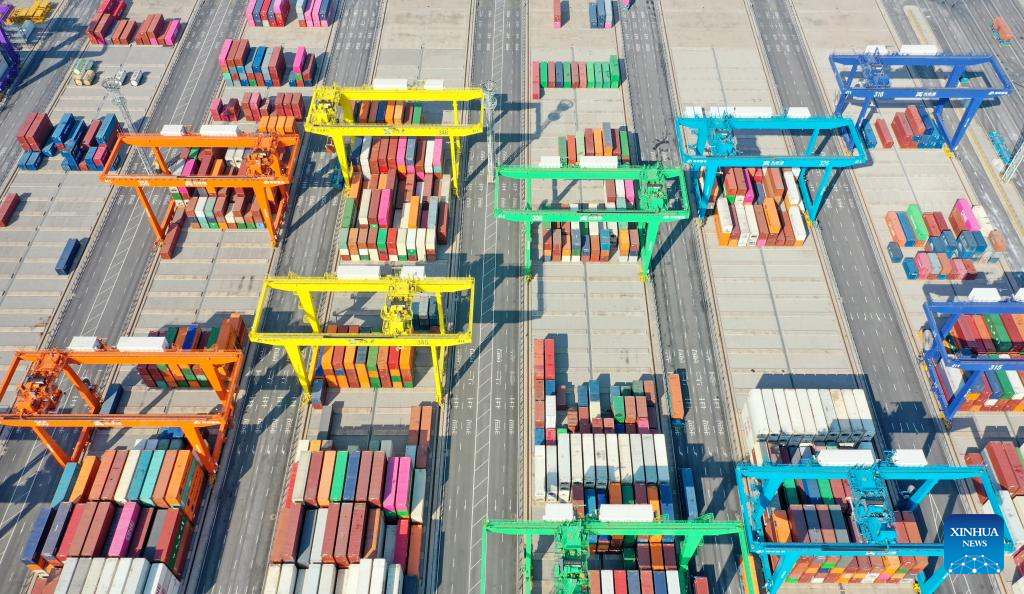
This aerial photo taken on Feb. 21, 2023 shows the full Internet of Things container terminal of Tianjin Port in north China's Tianjin.
As the "maritime gateway" to the Beijing-Tianjin-Hebei region, Tianjin Port has been ceaselessly advancing the construction of a smart port, boosting the coordinated development of the region with fresh impetus.
A full Internet of Things container terminal started operations in January this year in Tianjin Port, which connects six IoT elements, including people, vehicles, containers, ships, aircraft, and sites.
Equipped with more than 100 thousand types of sensors, the terminal is upgraded from a smart container terminal with zero carbon emissions. (Xinhua/Zhao Zishuo)
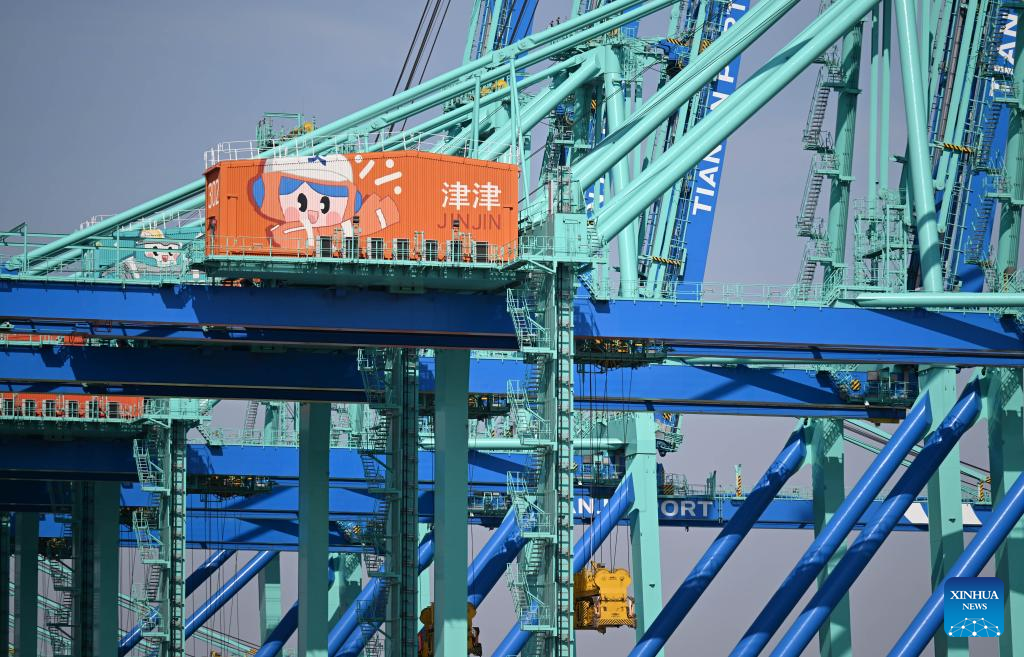
This photo taken on Feb. 21, 2023 shows the full Internet of Things container terminal of Tianjin Port in north China's Tianjin.
As the "maritime gateway" to the Beijing-Tianjin-Hebei region, Tianjin Port has been ceaselessly advancing the construction of a smart port, boosting the coordinated development of the region with fresh impetus.
A full Internet of Things container terminal started operations in January this year in Tianjin Port, which connects six IoT elements, including people, vehicles, containers, ships, aircraft, and sites.
Equipped with more than 100 thousand types of sensors, the terminal is upgraded from a smart container terminal with zero carbon emissions. (Xinhua/Li Ran)
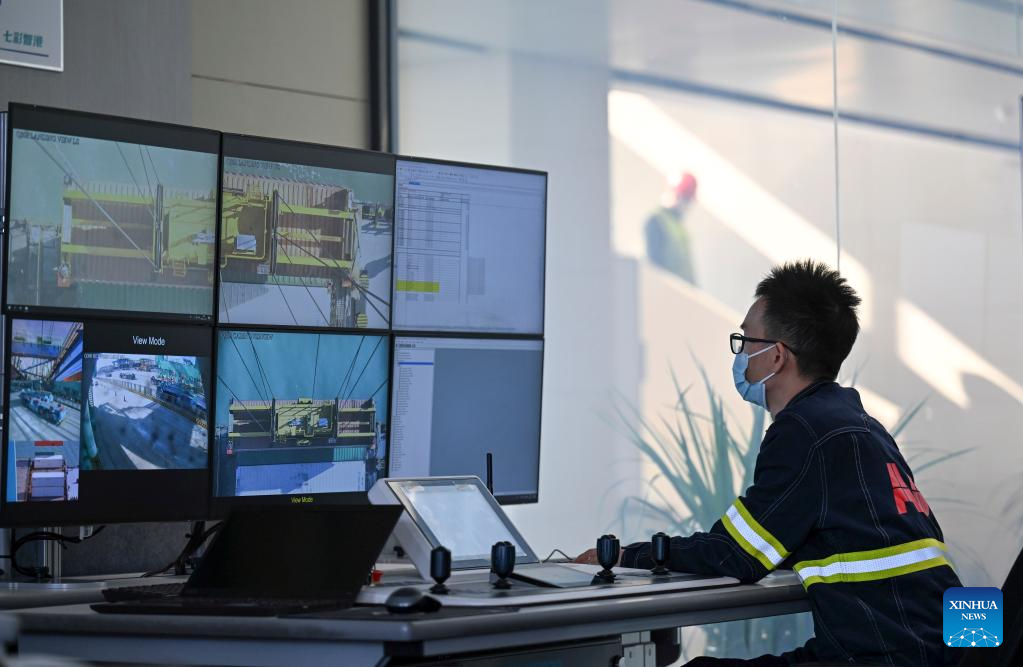
A staff member checks equipment at the technology center of the full Internet of Things container terminal of Tianjin Port in north China's Tianjin, Feb. 21, 2023.
As the "maritime gateway" to the Beijing-Tianjin-Hebei region, Tianjin Port has been ceaselessly advancing the construction of a smart port, boosting the coordinated development of the region with fresh impetus.
A full Internet of Things container terminal started operations in January this year in Tianjin Port, which connects six IoT elements, including people, vehicles, containers, ships, aircraft, and sites.
Equipped with more than 100 thousand types of sensors, the terminal is upgraded from a smart container terminal with zero carbon emissions. (Xinhua/Li Ran)

This aerial photo taken on Feb. 21, 2023 shows the full Internet of Things container terminal of Tianjin Port in north China's Tianjin.
As the "maritime gateway" to the Beijing-Tianjin-Hebei region, Tianjin Port has been ceaselessly advancing the construction of a smart port, boosting the coordinated development of the region with fresh impetus.
A full Internet of Things container terminal started operations in January this year in Tianjin Port, which connects six IoT elements, including people, vehicles, containers, ships, aircraft, and sites.
Equipped with more than 100 thousand types of sensors, the terminal is upgraded from a smart container terminal with zero carbon emissions. (Xinhua/Zhao Zishuo)

A smart delivery robot works at the full Internet of Things container terminal of Tianjin Port in north China's Tianjin, Feb. 21, 2023.
As the "maritime gateway" to the Beijing-Tianjin-Hebei region, Tianjin Port has been ceaselessly advancing the construction of a smart port, boosting the coordinated development of the region with fresh impetus.
A full Internet of Things container terminal started operations in January this year in Tianjin Port, which connects six IoT elements, including people, vehicles, containers, ships, aircraft, and sites.
Equipped with more than 100 thousand types of sensors, the terminal is upgraded from a smart container terminal with zero carbon emissions. (Xinhua/Li Ran)



